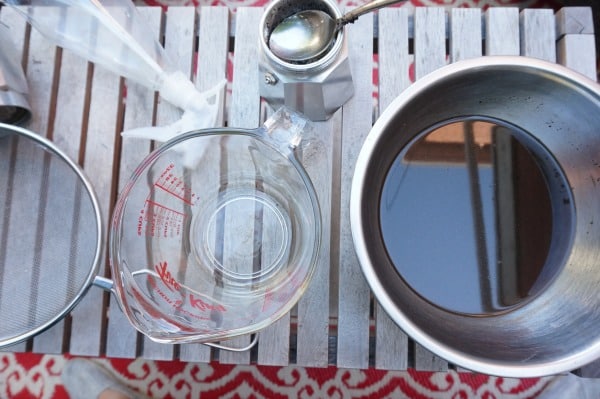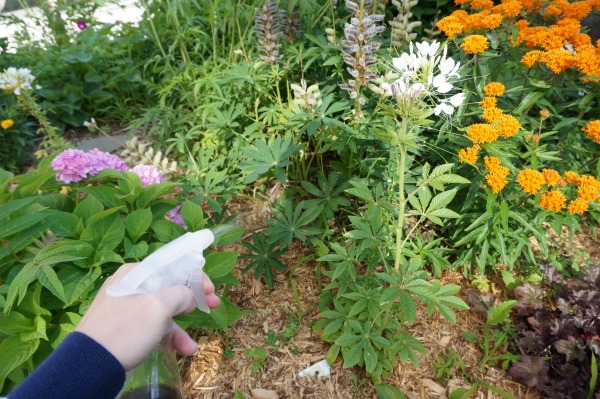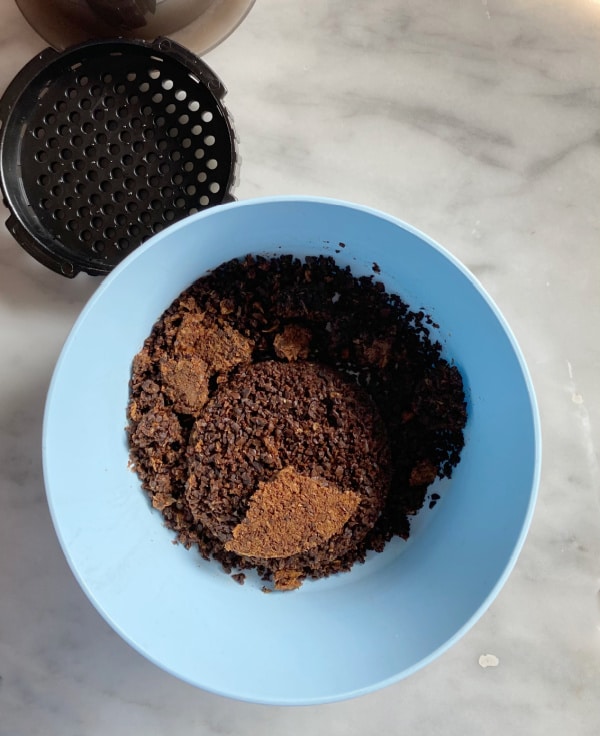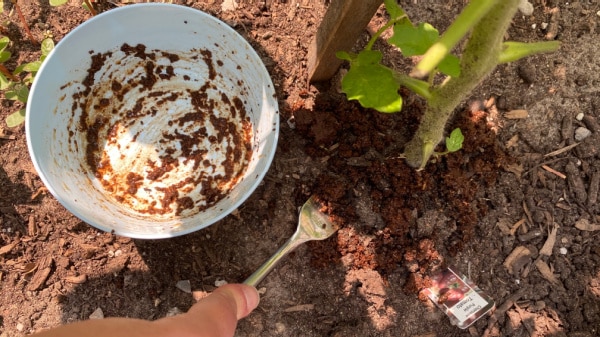Lets get back to tips for building an awesome home garden. The girls and I were in line at Starbucks the other day when we saw a bin full of silver bags and a sign that said “Used Coffee Grounds Bags.” for free. Always in search of a “good deal” we grabbed a bag and brought it back to our garden. Ever wonder how to use coffee grounds in the garden? We know everything you need to know!
There are Amazon Affiliate links in this article. This doesn’t cost you anything extra, but it means we might get paid for suggesting these products. You can read our full disclosure policy on our Disclosure Page for more details.
As a gardener and coffee lover, you may have wondered if used coffee grounds can give your potted basil plants a boost With its popularity in kitchen herb gardens, basil is a prime candidate for coffee ground fertilizing experiments But are coffee grounds actually good for container basil? This article covers using spent coffee to safely nourish indoor basil plants.
An Overview of Coffee Grounds as Fertilizer
Coffee grounds contain beneficial nutrients that, in moderation, can fertilize plants. The grounds provide:
-
Nitrogen – Around 2% nitrogen that fuels leafy growth.
-
Potassium – Helps plants resist disease and supports flowering and root health.
-
Phosphorus – Critical for photosynthesis, blooming, and fruiting.
-
Micronutrients like iron magnesium, and manganese.
However, coffee grounds do have some downsides to be aware of:
-
Acidity – Breaking down grounds make soil more acidic. Not all plants prefer this.
-
Salts – Excess sodium and salts can potentially burn plant roots.
-
Rapid nitrogen release – Dry grounds may quickly leach nitrogen before roots absorb it.
So while used coffee can nourish plants, its acidity and salt levels require cautious application. This is especially true for container gardens.
Are Coffee Grounds Beneficial for Potted Basil?
How does fertilizing with spent coffee grounds impact potted basil specifically? Here are key factors to consider:
-
Soil pH – Basil grows best in slightly acidic to neutral soil around 6.5-7.0. But decomposing grounds will increase acidity.
-
Nutrient needs – Nitrogen in coffee grounds promotes the leafy growth basil loves.
-
Salt sensitivity – Basil’s roots can be damaged by a buildup of excess salts from grounds.
-
Soil nutrition – Container soil needs added nutrients coffee can provide.
-
Use grounds sparingly – thin layers just 1/4 inch deep around plants
-
Mix grounds into the top few inches of soil to dilute acidity and salt levels
-
Alternate coffee grounds with more pH neutral organic fertilizers like compost tea
-
Avoid accumulations of dry grounds on the soil surface
Best Practices for Fertilizing Basil With Spent Coffee
Here are some methods for safely giving container basil a gentle nutrient boost from used coffee:
Direct Soil Application
-
Spread a thin 1/4 inch layer of spent grounds around plant bases.
-
Use a trowel or fork to lightly mix grounds into the top 2-3 inches of potting soil.
-
Water thoroughly after applying to further distribute nutrients and acids.
-
Reapply monthly or every 6-8 weeks for a slow release fertilizer effect.
Diluted Coffee Fertilizer
-
Brew a concentrated coffee ground “tea” by soaking grounds in water for a day at a 1:1 ratio.
-
Dilute the concentrate 2:1 with plain water to reduce burning risks.
-
Pour the diluted liquid fertilizer over the soil until it drains from the container’s bottom.
-
Fertilize basil every 2-3 weeks with the diluted grounds tea.
Coffee Ground Surface Mulch
-
Spread used grounds lightly on the soil around plants as a thin mulch topdressing.
-
Avoid coatings of grounds that can lead to excessive salt and acid accumulation.
-
Reapply fresh mulch layer every month or two after turning existing grounds into the soil.
The key is using coffee grounds in moderation. Test small areas first and watch for any yellow or brown leaf discoloration indicating overuse. Adjust application amounts and timing as needed for your specific growing conditions.
What Other Potted Herbs Can Use Coffee Grounds?
In addition to basil, many popular culinary herbs can be fertilized with spent coffee in containers:
-
Parsley – Loves nitrogen and can handle more acidity than basil.
-
Oregano and thyme – Appreciate the mild soil acidity and nutrient boost coffee provides.
-
Sage – Tolerates average to slightly acidic conditions if drainage is adequate.
-
Mint – Grows aggressively so nitrogen from grounds fuels leafy growth. Requires consistent moisture.
-
Rosemary – Does well in average to acidic soil. Allow potting mix to dry out between waterings.
As when fertilizing any plant, start with light coffee ground applications for herbs and closely monitor their health and response.
Are Coffee Grounds Good for Outdoor Garden Beds?
Used coffee can also nourish vegetables, flowers, shrubs and trees grown in garden beds. Effective techniques include:
-
Composting grounds to slowly mellow their acidity as they break down
-
Digging grounds 6-12 inches deep into beds to dilute their impacts
-
Using grounds as a mulch layer to suppress weeds and retain soil moisture
-
Fertilizing acid-loving plants like azaleas, blueberries, hydrangeas, and evergreens
The larger soil mass in garden beds helps buffer coffee’s acids and salts. Rainfall also helps prevent buildups. Feel free to apply more generous amounts of used grounds around established outdoor plants.
Troubleshooting Overuse of Coffee Grounds
Watch for these signs that too much coffee fertilizer has been applied:
-
Leaf browning or yellowing from excessive acids or salt accumulation
-
Stunted growth since too much nitrogen can limit plant development
-
Poor flowering and fruiting as nitrogen encourages more leaves over flowers/fruits
-
Mold growth as wet grounds can become moldy and spread spores
Flushing pots with clean water to remove excess salts and acids can help recover over-fertilized plants. Then resume fertilizing cautiously at lower doses.
When used in moderation, coffee grounds can be a safe, effective fertilizer for container basil. But monitor plant health closely and adjust application amounts as needed. With the right careful approach, spent coffee can boost indoor and outdoor plants while reducing food waste.
![]()
Are coffee grounds safe for basil and other herbs?
Yes, coffee ground fertilizer is safe for basil and other herbs. Again, just use it sparingly. Herbs definitely benefit from the nitrogen boost that coffee grounds provide.
How to Make Coffee Ground Fertilizer for Plants

Whos to say you cant steep old coffee grounds? Its super simple to make coffee ground liquid fertilizer. Heres our coffee ground fertilizer recipe. Put 2 cups of used coffee grounds into a 5-gallon bucket of water and let it sit overnight. Fill a spray bottle with the coffee mixture and spray it onto garden plants. Using a spray bottle helps make sure that you dont overdose the plants in your garden.

Alternatively, you can skip the steeping and add the coffee grounds directly to your soil. Add a few scoops of used coffee grounds to a small bowl and add water to dampen them. Put the coffee grounds right around the base of your tomato plants, basil plants, or any other plants you want to feed.


Use a kitchen fork to work the coffee grounds into the top layer of the soil. When you water the garden the coffee will seep into the soil and work its magic. This is the easiest way to directly feed your plants. This method also helps you to feed the specific plants you want to feed.
Are Coffee Grounds Good For Plants?
FAQ
What is the best fertilizer for basil?
How often should I add coffee grounds to my plants?
How do I make my basil plant happy?
What plants should I not put coffee grounds on?
